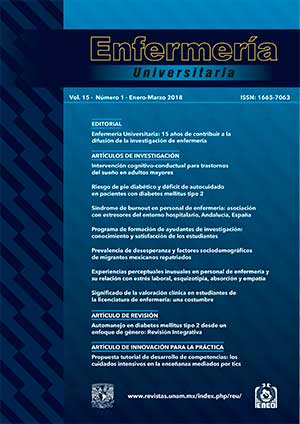Burnout syndrome among nursing staff: hospital-environment stress associations, Andalucia, Spain
Main Article Content
Abstract
Introduction: The burnout syndrome is highly prevalent in the health care environments which normally include high levels of responsibility, direct contact with many persons, and near death experiences, among other stressful situations. This syndrome is a direct cause of absenteeism and thus its prevention becomes important.
Objective: Based on the Maslach Inventory, to identify the prevalence of burnout among nursing personnel and its associations with the stressors contemplated by the Nursing Stressor Scale (NSS).
Method: This is an observational, descriptive, transversal and prospective study. The population is constituted by 140 nursing professors working at the Montilla Hospital in Spain. The representative sample of 43 was obtained by probabilistic sampling. Associations were found between emotional wasting, depersonalization, and individual achievement (Maslach Burnout Inventory) with each of the 9 factors measuring the presence of stressors contemplated by the NSS. The Pearson coefficient and the Student’s t were calculated.
Results: There are associations between diverse levels of emotional wasting and the following stressors: death and suffering, workload, uncertainty regarding the treatment, hierarchy problems, insufficient preparation, problems among nursing staff, and moving to other services lacking enough personnel. Regarding depersonalization, the different levels are associated with: uncertainty about the treatment, insufficient preparation, and problems among the nursing personnel.
Conclusions: Directly addressing the factors associated with emotional wasting will allow healthcare managers to prevent the incidence of burnout syndrome among the staff.
Publication Facts
Reviewer profiles N/A
Author statements
- Academic society
- N/A
- Publisher
- Universidad Nacional Autónoma de México
Article Details
Dimensions citation
MÉTRICAS
Enfermería Universitaria by Universidad Nacional Autónoma de México it is distributed under the License Creative Commons Attribution - NonCommercial - NoDerivatives 4.0 International
Accepted and published articles become open-access under the terms of the Creative Commons CC BY-NC-ND 4.0 license, which authorizes the reproduction and sharing without commercial purposes, provided the corresponding acknowledgments to their authors. Authors are allowed to manage a self-archive copy of the article’s published version so that they can open-access it in their personal or institutional web pages, and/or any other broad-diffusion space.


